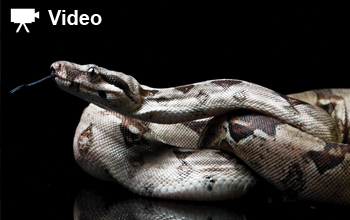News Release 09-121
The Secret of a Snake's Slither
Mathematicians uncover the hidden patterns and movements that snakes use to move without legs
June 9, 2009
View a video of researchers explaining how snakes move without legs.
This material is available primarily for archival purposes. Telephone numbers or other contact information may be out of date; please see current contact information at media contacts.
Snake locomotion may seem simple compared to walking or galloping. But in reality, it's no easy task to move without legs. Previous research has assumed that snakes move by pushing off of rocks and debris around them. But a study published this week in the Proceedings of the National Academy of Sciences says that it's all in their design--specifically, their scales.
Overlapping belly scales provide friction with the ground that gives snakes a preferred direction of motion, like the motion of wheels or ice skates. Like wheels and ice skates, sliding forward for snakes takes less work than sliding sideways.
In addition, snakes aren't lying completely flat against the ground as they slither. They redistribute their weight as they move, concentrating it in areas where their bodies can get the most friction with the ground and therefore maximize thrust. In this way, snake slithering is not unlike human walking--we, too, shift our weight from left to right to enable us to move.
-NSF-
Media Contacts
Dana W. Cruikshank, NSF, (703) 292-7738, email: dcruiksh@nsf.gov
The U.S. National Science Foundation propels the nation forward by advancing fundamental research in all fields of science and engineering. NSF supports research and people by providing facilities, instruments and funding to support their ingenuity and sustain the U.S. as a global leader in research and innovation. With a fiscal year 2023 budget of $9.5 billion, NSF funds reach all 50 states through grants to nearly 2,000 colleges, universities and institutions. Each year, NSF receives more than 40,000 competitive proposals and makes about 11,000 new awards. Those awards include support for cooperative research with industry, Arctic and Antarctic research and operations, and U.S. participation in international scientific efforts.
Connect with us online
NSF website: nsf.gov
NSF News: nsf.gov/news
For News Media: nsf.gov/news/newsroom
Statistics: nsf.gov/statistics/
Awards database: nsf.gov/awardsearch/
Follow us on social
Twitter: twitter.com/NSF
Facebook: facebook.com/US.NSF
Instagram: instagram.com/nsfgov



